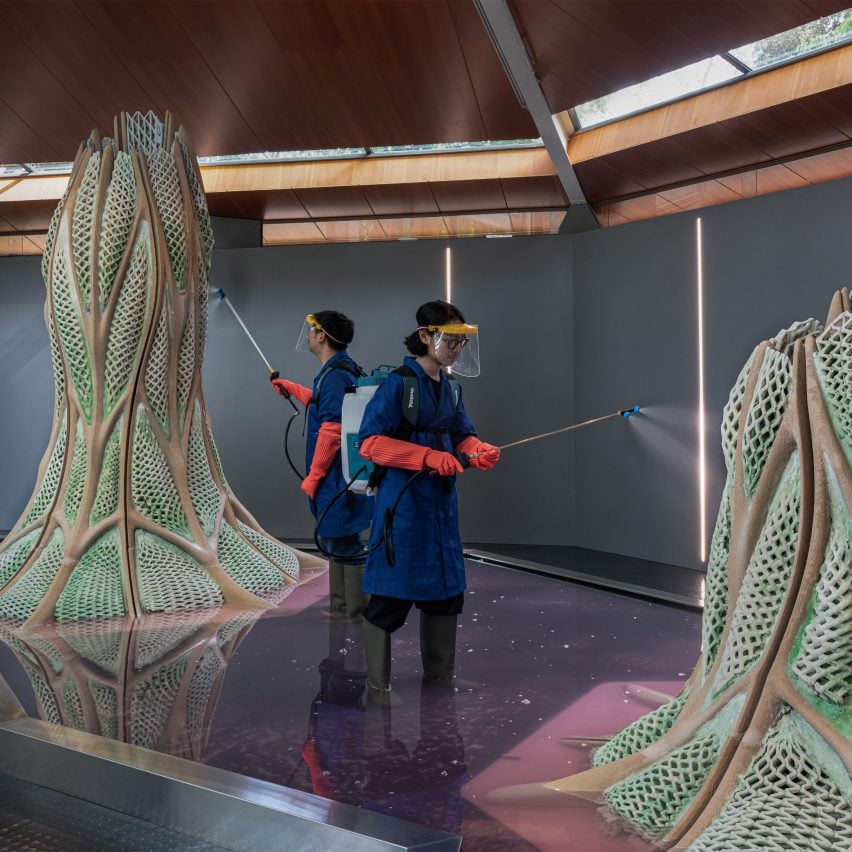Alien-like structures that sequester carbon emerge from shallow pools at the Canada Pavilion at this year’s Venice Architecture Biennale.
Named Picoplanktonics, the pavilion’s exhibition was curated by architecture and science group Living Room Collective, which wanted to showcase how the built environment can evolve to help the planet, rather than contribute to its destruction.

Building upon research by the group’s lead member, Andrea Shin Ling, Picoplanktonics features curving 3D-printed structures made from expanded glass with lattice infills coated with cyanobacteria. Smaller structures were also exhibited in glass box “incubation chambers”.
Living Room Collective used a form of marine plant cyanobacteria on the structures that sequesters carbon in two ways – through photosynthesis and biocementation, meaning it takes carbon from the air and turns it into minerals.

“Andrea has developed a bio-fabrication platform that’s capable of printing living structures at architectural scale, and what this fabrication platform is doing is combining sedimentary material with living bacteria,” Living Room Collective member Clayton Lee told Dezeen.
The Picoplanktonics structures will grow at a very slow rate, but Lee explained that the pavilion’s main goal is to propose how we could build in ways that put the planet’s needs before our own.

“The ramifications of these structures we made won’t be seen for decades or even centuries, because of how slow the scope is,” Lee said.
“Architecture is often about making things easier, faster, cheaper for the human, and we’re actually thinking about the opposite – how do we as humans have a responsibility to the earth, and how do we properly take care of it?”

The lattice structures were 3D printed at ETH Zurich university and were designed to maximise surface area so more bacteria are exposed to the air.
“The bacteria do not naturally make these structures, but we structured the geometry in such a way that it’s meant to support its own weight as it grows,” said Lee.
Lighting, moisture and temperature in the pavilion building were adapted to facilitate the cyanobacteria’s growth, and chemicals were added to shallow pools to mimic sea water.
As the biennale continues over the months, pavilion staff will tend to and water the bacteria, demonstrating how humans and living structures might co-exist.

Lee argued that not only do the bacteria sequester carbon, but they also permanently store carbon in the minerals they produce.
“When a tree dies, it releases all the carbon that’s stored back into the environment, whereas when these die, it permanently stores them,” he said. “One of the big things we’re thinking is, how do we not only design across scale, but design across time?”

The tall, curving structures were designed to reference a tree puncturing the pavilion building, but Lee explained that future applications of Picoplanktonics could be building facades.
He said that there is an urgent need for construction methods like Picoplanktonics, but, partly because the material needs high levels of moisture, it would require a change in lifestyle.

“We joke that it’s not fit for use for 10 years, but actually, we feel urgent about this,” Lee said.
“Using the biennale as a context, we’re encouraging folks to have a conversation around shifting human behaviour to be in support of nature versus the ongoing exploitation.”
Elsewhere at the Venice Architecture Biennale, the US created a mass-timber canopy to celebrate porches and the main exhibition in the Arsenale featured an array of robots.
The photography is by Living Room Collective.
The Venice Architecture Biennale takes place from 10 May to 23 November 2025. See Dezeen Events Guide for all the latest information you need to know to attend the event, as well as a list of other architecture and design events taking place around the world.
The post Canada "prints living structures" at Venice Architecture Biennale appeared first on Dezeen.

